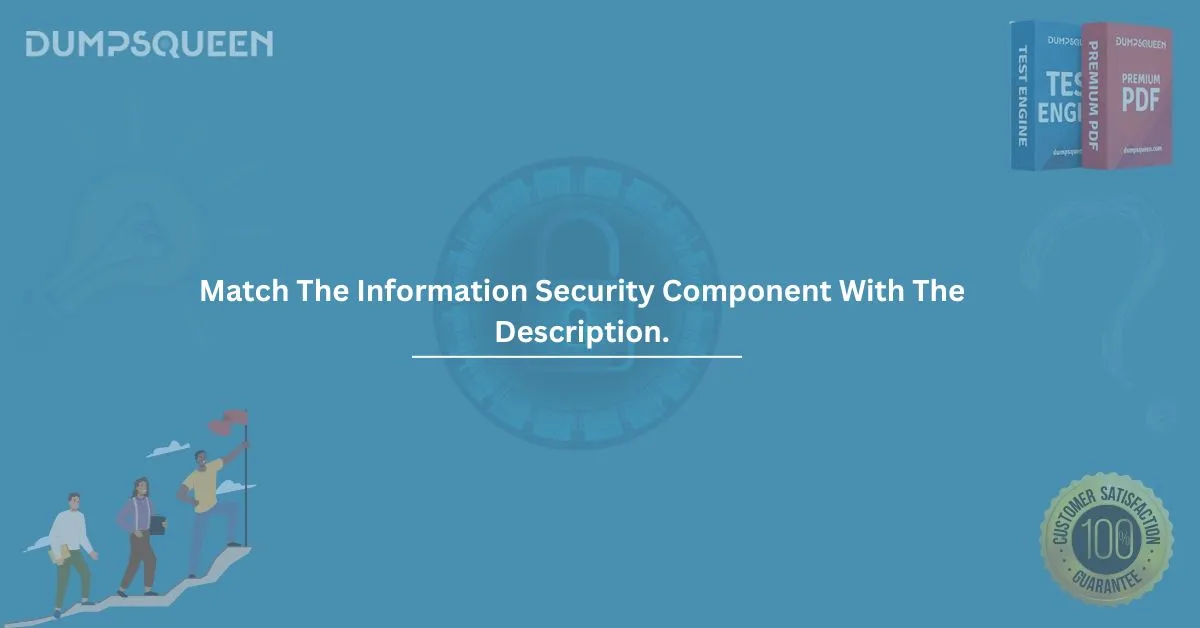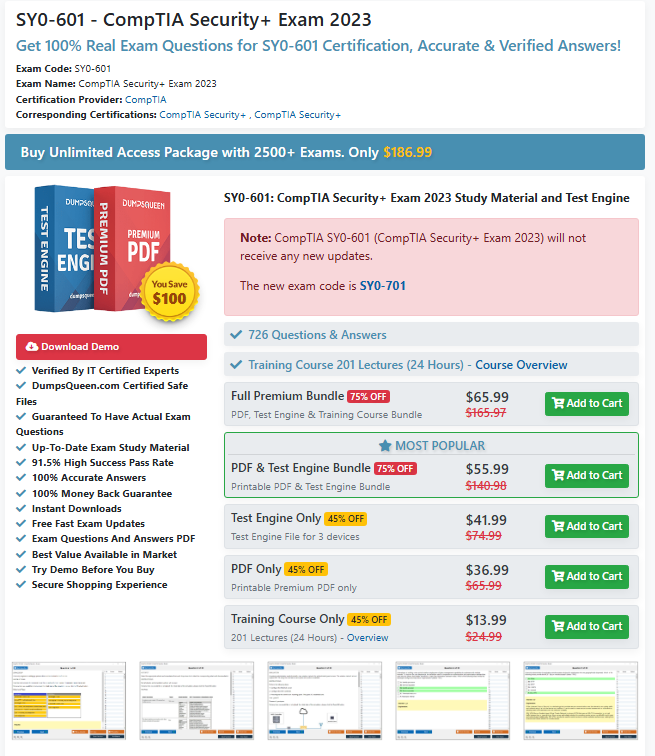In the ever-evolving world of cybersecurity, understanding the core components of information security is not just essential—it's critical. Whether you're preparing for a certification exam, pursuing a career in information technology, or aiming to strengthen your organization's digital infrastructure, being able to match the information security component with the description is a foundational skill.
At DumpsQueen Official, we provide clear, concise, and up-to-date content that makes your certification journey smoother. This blog post will help you master the concept of matching security components with their respective descriptions—a common question type in IT certification exams like CompTIA Security+, CISSP, CISM, and more.
Let’s break down each core component of information security, provide easy-to-understand explanations, and finish with a few sample MCQs to test your knowledge.
What Are the Main Information Security Components?
Information security is traditionally defined by three primary components, collectively referred to as the CIA Triad. These are:
- Confidentiality
- Integrity
- Availability
However, modern security frameworks have expanded beyond the CIA Triad to include additional elements like:
- Authentication
- Authorization
- Non-repudiation
- Accountability
To properly match the information security component with the description, you need a deep understanding of each term and how it applies to real-world scenarios.
1. Confidentiality
Confidentiality ensures that sensitive information is accessed only by authorized individuals. For example, encryption of emails or documents prevents unauthorized reading. A breach in confidentiality can result in data leaks, identity theft, and a loss of organizational trust.
2. Integrity
Integrity guarantees that data is accurate, complete, and has not been altered. This is often achieved using cryptographic hash functions to verify data consistency. Maintaining integrity is vital to ensure correct and reliable information is used in decision-making.
3. Availability
Availability ensures that systems, services, and data are accessible when needed. Redundant systems, failover configurations, and distributed networks help maintain availability. Disruptions in availability can severely impact productivity and service delivery.
4. Authentication
Authentication involves verifying the identity of users or systems. Common methods include passwords, biometrics, and two-factor authentication (2FA). Proper authentication ensures that only legitimate users can access a system.
5. Authorization
Authorization determines what resources a user can access after authentication. An example is Role-Based Access Control (RBAC), where users have permissions based on their job role. Authorization prevents users from accessing data or services beyond their rights.
6. Non-repudiation
Non-repudiation ensures that a party in a communication cannot deny the authenticity of their signature or the sending of a message. Digital signatures are a popular method to achieve this. This is essential in financial, legal, and communication systems.
7. Accountability
Accountability means tracking user actions so that each action can be linked back to a specific user. Logs and audit trails are used to maintain accountability. It helps in identifying policy violations and investigating incidents.
How to Match the Information Security Component with the Description in Exams
IT exams often present questions asking candidates to match each component of information security with its definition or real-life application. This tests not only theoretical understanding but also practical application.
Understanding subtle differences between terms like authentication and authorization or confidentiality and integrity is crucial. This is where most exam candidates struggle, especially if they rely only on rote memorization. Practice and real-world context are key.
Why These Questions Matter in Certifications
Whether you're preparing for CompTIA Security+, CISSP, or CEH, being able to match the information security component with the description gives you a major advantage in multiple-choice exams. These concepts are foundational and are often part of more complex scenarios in advanced certifications.
Practicing these types of questions through DumpsQueen Official not only sharpens your accuracy but also trains your mind to identify these concepts in practical, job-related environments. This makes your exam preparation both efficient and job-ready.
Easy Strategies to Remember the Components
If you're having trouble remembering the various components, here are some simple techniques to help:
CIA Triad – Think of:
- Confidentiality: Who can see the data?
- Integrity: Is the data correct and untouched?
- Availability: Can we access the data when needed?
AAA Model – Think of:
- Authentication: Proving identity
- Authorization: Granting permissions
- Accounting/Accountability: Logging actions
Non-repudiation – Think “No Denial”: Users cannot deny their actions.
Use mnemonics like “CIA Always Acts Notably” for:
- Confidentiality
- Integrity
- Availability
- Authentication
- Authorization
- Non-repudiation
- Accountability
These tricks make it easier to recall during timed exams or stressful conditions.
Real-Life Scenario Combining All Components
Consider this example of an internal banking system:
An employee logs in using 2FA. Based on their role, they can only access customer profiles but not financial transaction records. All their activities are logged, and digital signatures are required for sending messages to other departments. All data is encrypted, regularly backed up, and hosted on high-availability infrastructure.
Here’s how each component plays a role:
- Authentication: 2FA login
- Authorization: Role-based access
- Accountability: Activity logs
- Non-repudiation: Digital signature
- Confidentiality: Encrypted records
- Integrity: File hashes and validation
- Availability: Redundant server setup
This scenario shows the interconnected nature of these components and how they contribute to a comprehensive security posture.
Common Mistakes to Avoid
Here are common errors students and professionals make when answering these types of questions:
Confusing authentication with authorization – Authentication is who you are, authorization is what you can do.
Overlapping confidentiality with integrity – Confidentiality is about access, integrity is about accuracy.
Ignoring accountability – In many organizations, accountability is enforced through system logs, which are critical for audits.
Forgetting non-repudiation – This is important in legal contexts and digital communications, and often overlooked.
Being aware of these mistakes helps you avoid wrong answers in exam situations.
How DumpsQueen Official Helps You Prepare
DumpsQueen Official provides high-quality, exam-specific resources that make concepts like match the information security component with the description clear and actionable. Our question banks, practice exams, and study guides are crafted by certified professionals with deep knowledge of exam patterns.
Here’s what you can expect:
Up-to-date questions that mirror real exams
Detailed explanations with real-world examples
Tips and tricks to remember tricky concepts
Access to premium dumps with verified answers
Our platform is designed to help you not just pass your certification exams but truly understand the content, making you a more confident and capable professional in the IT industry.
Final Thoughts
To successfully answer questions that ask you to match the information security component with the description, you need to do more than memorize definitions. You need a practical understanding, familiarity with real-world applications, and exposure to exam-style questions.
Use the CIA Triad and related concepts like authentication, authorization, and non-repudiation as the backbone of your study routine. Reinforce these with DumpsQueen’s expertly crafted materials to ensure you're fully prepared.
At DumpsQueen Official, we believe in empowering learners with clarity and confidence. Start practicing today and get closer to achieving your IT certification goals.
Sample MCQs – Match the Information Security Component with the Description
Question 1
Which information security component ensures that only those who are authorized can access specific data or systems?
A. Confidentiality
B. Authentication
C. Authorization
D. Integrity
Correct Answer: C. Authorization
Question 2
Which of the following is most directly concerned with ensuring data has not been tampered with?
A. Integrity
B. Availability
C. Authentication
D. Confidentiality
Correct Answer: A. Integrity
Question 3
The use of biometric systems like fingerprint scanners during login is an example of which component?
A. Availability
B. Authorization
C. Confidentiality
D. Authentication
Correct Answer: D. Authentication
Question 4
Digital signatures primarily support which information security component?
A. Integrity
B. Non-repudiation
C. Availability
D. Authorization
Correct Answer: B. Non-repudiation




